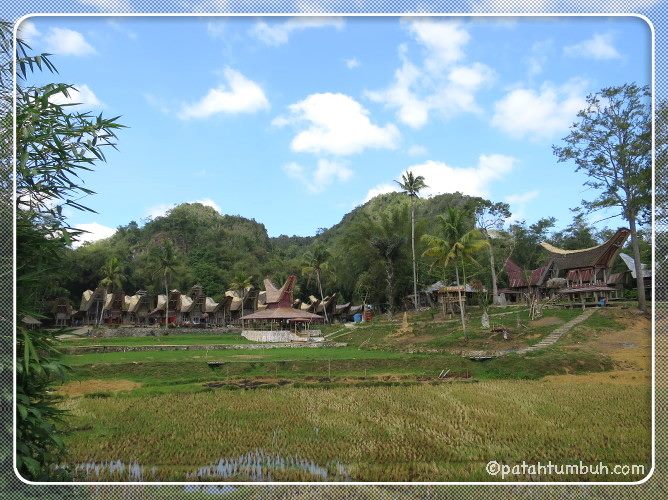Ke’te Kesu’
After watching the buffaloes spurting blood from their slit neck the first morning of our stay in Rantepao, we went to Ke’te Kesu’, 4 km southeast of Rantepao. Kete Kesu opens for tourists from 8.00 to 16.00. Located in Sanggalangi district, North Toraja, it is believed to be more than 500 years old, makes it one of the oldest and most complete settlement in Tana Toraja. Ke'te Kesu' is one of Unesco World Heritage nominee.
Admission fee is Rp 20,000 for foreigners.



A traditional Torajan settlement consists of tongkonans (traditional houses) and alangs (granaries), liang (burial places), rante (ritual field), paddy fields, bamboo forests and pastures for their bufflaoes and pigs. Bamboo means everything for the Torajans. It's part of their daily life, from their living place, utensils, art and crafts, to their cuisine. Bamboo forests are crucial to them.
A Tongkonan is a wooden Torajan traditional house with no traces of metal (like nails), built with precision, facing north with roof shaped like a boat. It’s their belief that the source of life comes from north. Some believe that their ancestors came from north (Indo China). The walls are carved and painted beautifully. The front door is made low so one has to stoop to enter. This is due to their life philosophy: a guest has to respect the house owner. The roof is made from pieces of facing-downward-halved bamboo arranged on top of two facing-upward ones to protect it from the rain. It also provides great air circulation. Torajan architecture is well known and used by many around the world.

There is a long pole in front of the house that stands up to the ceiling to hang buffaloes’ horns. The more horns displayed, the more the prestige of the house owner. White buffalo head indicates the house of the village leader.

Every tongkonan is paired with a rice barn (alang) where they keep their rice above and welcome guests on the platform below. Not every guest is allowed to sit there. A friend told me that he was once chastised when he sat there uninvited but after learning who he was, the host apologized because he actually is a noble-born. An alang has six pillars made of banga tree (a kind of palm tree). Our guide said it is very strong and slippery that mice can not climb in or make holes.

Tongkonans play an important role in Torajan society. They are built under the labor of many, and following lots of rules and regulations.
In certain villages, a house is called a tongkonan only after at least seven generations had lived inside and had been renovated over and over again. There are many ancient tongkonans throughout the region. Every Tongkonan has its own name. The first couple that built the house is called Pangraruk. Outside Toraja, the Torajans built a tongkonan look alike as a place for family meetings. (Tongkon means to sit).









Rante Kalimbuang
From Ke’te Kesu’ we went to have our lunch and some sightseeing before we headed to Rante Kalimbuang in Bori Village, Sesean District, about 5 km north of Rantepao. Admission fee, as in all other tourist sites here is Rp 20,000 for foreigners (a little bit over one dollar).

Rante is a funeral ritual site for the nobles. Rante Kalimbuang is the oldest in Toraja, believed to be more than 700 years old. Biggest rituals had been held here on this rante. After the deceased is buried, a menhir will be erected for him here. First, the family will have to find a simbuang batu (menhir), then they have to shape it like a person. Next, they move it to rante with manual labor only, sometimes this takes months especially if the menhir is huge. The last ritual will be erecting it inside the rante. There are 102 menhirs here at Rante Kalimbuang now.



Couldn't wait till the next day when we were going to visit more burial sites.
Previous - Toraja: The Sacrificed Animals at Rambu Solo - III
Next - Toraja: Where the Dead are Part of the Living Life - IVB


Add new comment